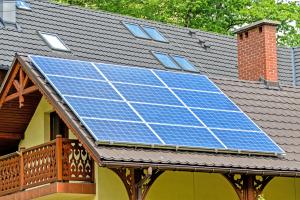- 6 reads

Everyone is searching for sources of renewable resources. Solar energy has become a very popular selection for an electricity source. Everything from solar phone chargers to outdoor lighting can now be found. Using any device that runs on renewable energy is a step in the right direction. Even if you do not think these little things will make a difference, these instances refrain from using nonrenewable resources like coal, oil, or natural gas. Since these resources take so long for the earth to generate, the earth will not be able to replace them in our lifetime or our grandchildren’s’ lifetime. It is difficult to accurately measure the amount of oil left in the reserves around the world.
Due to the uncertainty with the fossil fuel supplies, some people are taking bigger steps than just solar lights for their garden. Many people have converted their home to run off of solar power. In order to successfully transition your home to solar energy, you have to do some careful planning. Some key factors to consider are anticipated energy consumption, available space, panel location, and spending budget.
Energy Consumption
The first thing to determine is how much energy you will need to produce. The last thing you want to do is spend your money on a solar energy system that does not produce enough electricity to power your home. Most electric companies will purchase any additional unused electricity; so it is better to produce too much rather than not enough. Generally, the process consists of connecting your system to your electricity meter and if you produce more than you use, the electric company will write you a check for the extra energy produced. Check with your local electric company for complete details. Another thing to consider is whether or not you would like to make some extra income from additional energy produced. If you determine you have money left in your budget after you have planned a system to support your basic needs, you can consider adding to the system to create a supplement income source.
Available Space
When people first began to harvest solar energy, there were not many options. Giant solar panels were about the only option to get the amount of energy for their home. However, as technology advances, so do the selection of available solar panels. A popular alternative to the traditional standalone panels are the solar shingles and roof tiles. These options take up less space because they are attached to already existing or planned structures. These units are simply laid over the existing roof. If the solar panels are installed as standalone units in a field, that field, and the surrounding fields are then limited to their potential uses. The area around the panels should not be used for structures that will cast shadows and reduce the efficiency of the system.
Panel Location
Panel location affects the amount of energy produced. Panels convert energy best in direct sunlight. Although solar panels produce energy as long as they are in daylight, the panels work more efficiently in direct sunlight. If your home or desired location is heavily shaded, solar panels may not even be a feasible option for you. Who would want to spend money on a solar electric system that will only operate at 20% efficiency? Even the weather can have an effect on the efficiency of your system. States that have consistent cloud cover, such as Washington, could significantly lower the effectiveness of the system.
Spending Budget
Establishing a spending budget can be tricky. You want to spend as little as possible, but you do not want to buy the cheapest panels available. Purchase quality panels that will last you for a long period of time. Most panels come with a 20-year warranty, but higher quality panels will last long after the established lifespan of the panel. As you determine how much you are able to spend on solar panels, consider the amount of money you will save each month on your electric bill. Consider applying this amount towards your budget to ensure you get exactly what you want and need from your solar electric system.
There is a lot to consider when you are planning to go green. With appropriate planning, you can make going green smooth and simple. You need to calculate your energy consumption, determine your available space and potential panel locations while staying on budget.
For more reviews on innovative products see: http://www.consumerschoicereviews.com/

